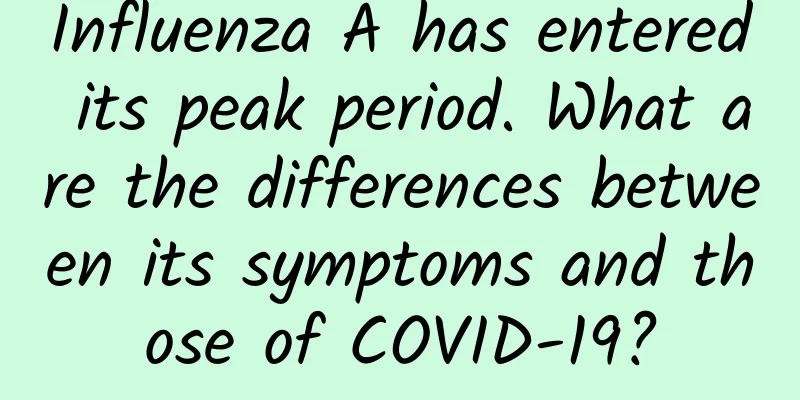Influenza A has entered its peak period. What are the differences between its symptoms and those of COVID-19?

|
Recently, influenza A has entered its peak period, and schools in Beijing, Shanghai, Zhejiang, Tianjin and other places have suspended classes due to students being infected with influenza A. Influenza A refers to influenza A, an acute respiratory infectious disease caused by influenza A virus, which often occurs in winter and spring. So, how should we prevent the aggressive influenza A? Can we distinguish influenza A from COVID-19 based on symptoms? Can influenza A and COVID-19 overlap? To this end, Science and Technology Daily interviewed Wang Baozeng, director of the Department of Infectious Diseases at Beijing Tiantan Hospital affiliated to Capital Medical University. The typical symptom of influenza A is fever, and the probability of superimposing COVID-19 is low. Influenza viruses can be divided into four major families: A, B, C, and D. Among them, influenza A is more common and is seasonally prevalent every year. The China Influenza Surveillance Weekly Report for the 7th week of 2023 released by the China National Influenza Center shows that influenza A has been the most severe recently. "The incubation period of influenza A is usually 1 to 3 days. The main symptoms are fever, muscle aches all over the body and headache. There may also be some milder respiratory symptoms, such as cough, runny nose, sore throat, etc." said Wang Baozeng. Wang Baozeng told Science and Technology Daily that influenza A and COVID-19 have similar upper respiratory tract symptoms. "Especially the impact on taste and smell is a characteristic of the new coronavirus," Wang Baozeng added. Regarding the superposition of influenza A and COVID-19, Wang Baozeng said the probability of this happening is very small, and even if it does occur, it is rare for non-high-risk groups to develop critical illness. "At present, most people in my country are immune to the new coronavirus, and the probability of being infected with the new coronavirus and influenza at the same time is very low. Even if the two viruses are infected at the same time, it will not necessarily become a critical illness. Whether it becomes a critical illness depends on the individual's physical constitution. For non-high-risk groups, even if they are infected with two viruses at the same time, their strong resistance will reduce the risk of critical illness." Wang Baozeng said, "But it is recommended that people who have not been infected with the new coronavirus continue to take good protection." Wang Baozeng told Science and Technology Daily that the antibodies produced after infection with influenza A are generally effective for half a year. "In the past three years, many people have not received influenza vaccines and have not had influenza due to good personal protection, so the level of influenza antibodies is relatively low. Recently, there have been more reports of infection due to the increase in crowds." Wang Baozeng said. To prevent influenza A, the first choice is to get a flu vaccine Wang Baozeng said that the most effective way to prevent influenza A is to get the flu vaccine. "It is recommended to get the vaccine before the influenza A epidemic begins, which is usually in October. Of course, you can also get the vaccine during the epidemic," Wang Baozeng said. Except for the flu vaccine, other protective measures against influenza A are basically the same as those against COVID-19. If you are infected with H1N1, don't panic. "For people with better physical conditions, symptomatic treatment can be given, and some people can recover on their own without treatment," said Wang Baozeng. "But for high-risk groups, such as infants, the elderly, and people with underlying diseases, it is still recommended to use antiviral drugs to reduce the occurrence of critical illness." "If the patient has symptoms such as persistent high fever, difficulty breathing, severe vomiting and diarrhea, he or she must seek medical treatment actively to avoid delaying the disease," Wang Baozeng emphasized. Wang Baozeng told Science and Technology Daily that after being infected with influenza A, one must pay attention to rest, and it is recommended to gradually resume exercise after 3 to 4 weeks. "Whether it is COVID-19 or H1N1, as long as a viral infection occurs, it may cause damage to some body organs, especially the heart. Therefore, resting for 3 to 4 weeks after infection before exercising can reduce the risk of viral myocarditis." Wang Baozeng said. |
Recommend
Still using enumerations? I gave up on them a long time ago! (Android annotations explained)
Preface: Use Support Annotations to optimize code...
South Korea's National Statistical Office: South Korea's semiconductor shipments fell 22.7% in July 2022 from the same period last year
South Korean chipmakers' factory shipments fe...
User operation: Can you survive without growth?
Introduction: " Refined user data is not obt...
They would rather rob than hunt! This is a beautiful pirate bird in the Caribbean
Located in Old Havana, Cuba, Morro Castle is one ...
When performing minimally invasive heart surgery, why do we need to put a "plaster" on the patient first?
In every minimally invasive cardiac surgery anest...
Smart eating in winter - cooking secrets to reduce salt without reducing flavor
The salt intake in the diet of Chinese residents ...
3 perspectives to help you understand Toutiao’s content production strategy
Toutiao is a recommendation engine product based ...
Operational promotion: 4 commonly used mechanisms for attracting new users!
My understanding of user- attracting products inc...
Can sitting on a hot stone block cure menstrual cramps? According to the doctor...
recently A stone pillar from Xi'an became an ...
Congratulations! 81 individuals and 50 teams won the National Engineer Award! What is the difference between an engineer and a scientist?
Congratulations! 81 individuals and 50 teams won ...
WeChat Index is here, how to use it well is limited only by your imagination
Recently, WeChat launched the " WeChat Index...
China Automobile Dealers Association: Passenger car retail sales in November 2020 increased by 11% year-on-year to 2.03 million units, up 4.4% month-on-month
In November, passenger car retail sales increased...
Xishuangbanna Mini Program Agency Company, how much does it cost to be an agent for a paper product mini program?
How much does it cost to be an agent for a paper ...









